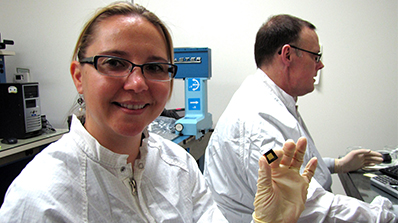The 2017 R&D 100 Awards recently announced their list of finalists, and our Geometrically Enhanced Photocathode project is among them! The project is led by Principal Scientist Dr. Kathy Opachich of Livermore Operations (LO) in Livermore, Calif.
Dr. Opachich worked with LO colleagues and collaborators from Lawrence Livermore National Laboratory, Lawrence Berkeley National Laboratory, General Atomics and NanoShift, LLC, to develop the recessed geometrically enhanced photocathode designed to improve high-energy efficiency in X-ray detectors. Kathy’s work also resulted in a full patent application and several publications.
Dr. Opachich conceived a way to break the limits of detector efficiency and performance in the soft X-ray range, which is largely limited by the total quantum electron yield. Most X-ray detectors operate at normal incidence (i.e., X-ray photons are at a 90-degree incidence angle to the photocathode) and suffer a loss in quantum efficiency at energies greater than 5 keV [kilo electron volts]. But improvements in yield of up to three times have occurred with grazing incidence geometry due to the larger path length of the X-ray photons, which better matches the secondary electron escape depth within the photocathode material. Using shallower angles can potentially improve the yield further (i.e., up to 10 times).
“The geometrically enhanced photocathode proves that we can push the limits on what we can do in quantum efficiency—that is, improve our ability to see finer detail in the dynamics of fusion experiments than before. Not being able to do this previously is what has limited our progress. With this geometrically enhanced photocathode, we’re getting better and more data, and it lets us view the dynamics of fusion much more clearly,” says Howard Bender, distinguished scientist at Los Alamos Operations in Los Alamos, N.M. Bender mentioned that areas where the geometrically enhanced photocathode would be useful is in other scientific research for probing states of matter, molecular dynamics, high-speed streak cameras and potential medical applications.
The R&D 100 Awards Committee and R&D Magazine announced the 2017 R&D 100 Award finalists, marking the 55th annual R&D 100 Awards program which honors the 100 most innovative technologies of the past year. The prestigious R&D Awards honor the latest and best innovations, identifying the top technology products of the past year. The finalists were selected by an independent panel of more than 50 judges representing R&D leaders in a variety of fields. This year’s R&D 100 winners will be announced at the annual black-tie awards dinner on Nov. 17 at the Walt Disney World Swan Resort in Orlando, Florida.

